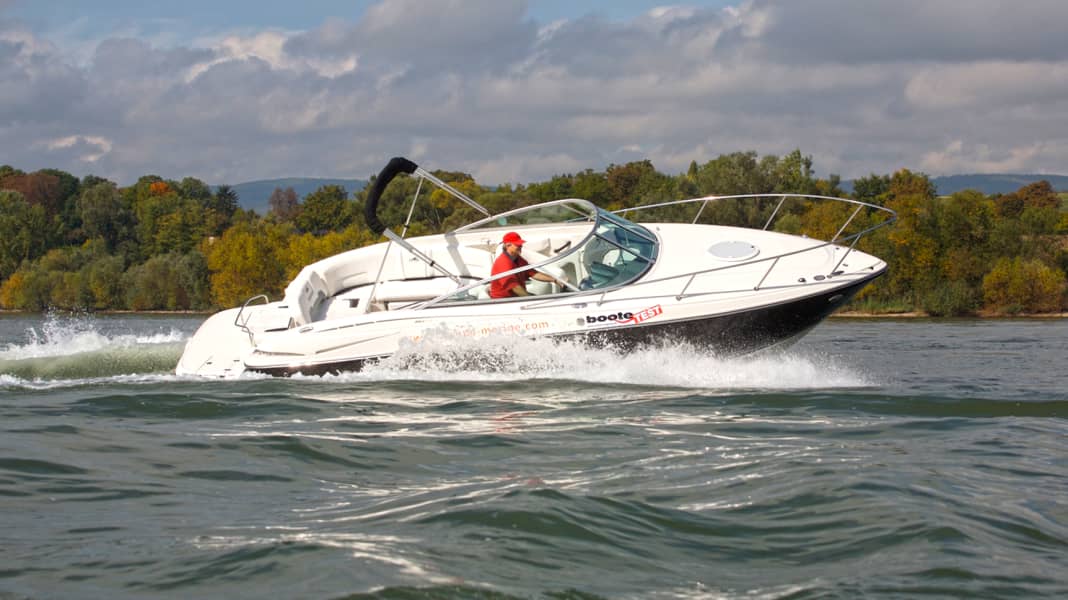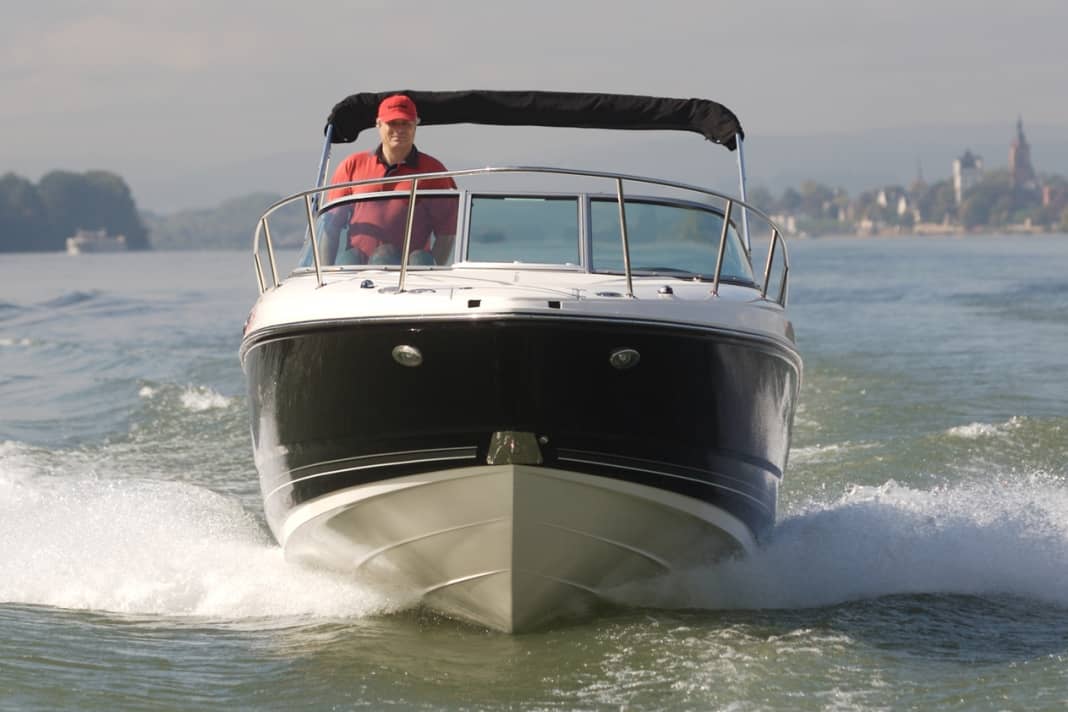
The cockpit of the Monterey 264 FSC has plenty of equipment and space for "life in the open air". Below deck, the asymmetrical berth and extra toilet room ensure an appealing level of travelling comfort for the short trip.






Monterey boats are not - as the name suggests - manufactured on the west coast of the USA, but on the east coast in Florida. With a few exceptions, the boat builders there do their work properly. There were almost no gaps in the protective coating on the inside of the hull and deck moulds and only the occasional laminate tip.
A negative feature is the pointed self-tapping screws for the frame attachment to the stowage box (stern passage). Better: the shipyard bolts the cleats with threaded bolts through reinforced laminate. The upholsterers and furniture makers also did a good job. Together, they produce a boat that weighs just under 2500 kg and can be towed with a 3.5 tonne trailer and a suitable towing vehicle, such as a Touareg or similar. The boat is categorised as CE category B, which means "outside coastal waters".
Driving and manoeuvring
Our test area, the Rhine near Wiesbaden, is located in the centre of the inland, but you shouldn't underestimate the swell in this region of the Rhine. That's because the commercial vessels churn up the waves, especially when there is heavy oncoming traffic. A short, choppy sea that puts a lot of strain on the hull.
Our test Monterey enters this choppy sea softly at a good 30 knots, but what does occur are strong, lateral splash water fountains.
side spray fountains. However, these are deflected to such an extent that nothing gets into the cockpit. No matter in which direction you jump over waves, the boat always remains stable. Of course, this also applies in calm water.
In the transition phase from displacement to planing speed, the V8 5.7 GI from Volvo Penta gets the 264 FSC "over the hill" in no time at all. Whether the drive is trimmed or not plays only a minor role in terms of foresight. Her top speed is a good 40 knots at 5100 rpm. That is 100 rpm above the permitted maximum speed. A difference that is compensated for by full equipment, full tanks and more people on board.
At full throttle, a good 2 l/sm of petrol runs through the line, which together with the 303-litre tank minus 15% reserve gives a range of just under 125 nm. The boat/engine combination runs most economically around 3500 rpm at 25.5 kn and then covers a distance of 173 nm, which is suitable for the type of boat.
The stern wave is quite powerful at slow planing speeds and flattens out as the speed increases. Together with good acceleration, these are suitable conditions for water skiing and wakeboarding.
If you want to make a tight turn, the best way to do this is with the Z-drive trimmed down. There are no affectations such as rocking or hooking, but the carpool still has to hold on tightly, as the hull follows such narrow tracks that strong lateral forces occur.
On the other hand, steering out of a circle is child's play with the smooth steering. If you jerk the steering wheel, the rear end comes in smoothly and the Monterey follows the steering inputs directly on a slalom course.
The situation is different when reversing slowly.
From port to starboard, the reversing of the bow is delayed by about 7 seconds. It only works in the other direction if the boat is intercepted with "short ahead" and then engaged in reverse again. The limit for fast reversing is a good 2000 rpm. Above this limit, swell sloshes into the cockpit.
The boat yaws slightly when travelling slowly forwards between around 4 knots and 6.5 knots, but only needs to be corrected slightly from time to time. Weight shifts by an adult only have a minor effect on the course. The skipper cannot tell exactly which course he has taken because the important compass is missing, even though it is a category B boat.
The standard navigation instruments are the speed display and depth sounder (partially concealed by the steering wheel). Apart from slight reflections, the engine and speed display are easy to read. The steering and single-lever gearstick are easy to reach and precise. The driver and co-driver sit on sporty upholstered bucket seats that rest on solid tubes, and the co-driver has a plastic handle on the side to hold on to.
When seated, both look through the safety glass windscreen in the sturdy metal frame. The 1.80 metre tall driver has the latter in his field of vision when he sits on the folded-up seat cushion. If the rider is positioned correctly, he is exposed to the full force of the wind, but otherwise has a good view forwards. Anyone riding in the rain will immediately recognise one shortcoming: there are no windscreen wipers.
Engine, tank, electrics
The V-aft stands on solid foundations in a spacious and service-friendly engine compartment, which is easily accessible via the folded-up sunbed aft. On the downside, the flap rubs against the side of the bench cushion when opening and closing. The shipyard glues self-extinguishing sound insulation to insulate the engine noise. It fulfils its task passably well up to cruising speed, but beyond that it gets loud up to a maximum of 93 dB/A.
The installation of pipes and hoses is of the usual American standard, as is the installation of a valve instead of a petrol tap in the fuel line. The same judgement applies to the fuel cleaning with only the engine's own filter and the fastening of the hoses with only a screw clamp.
Two well-dimensioned 88 Ah batteries (secured with belts) supply the engine and 12 V on-board power supply. In order to be able to switch them accordingly (1 or 2 or both), the shipyard installs a selector switch, which is just as easy to reach in the wetbar cabinet as the corresponding automatic machines.
Security
Good handling characteristics, suitable cockpit side height inside, large escape hatch, standard engine compartment fan and the fire extinguishing system in the engine compartment receive praise. Two electric bilge pumps are convenient, but cannot sufficiently fulfil the BOOTE standard due to the lack of a manual bilge pump that also works without electricity - especially as the cockpit drains into the bilge.
If you want to get in and out of the water easily, you can do so via a long ladder on the huge bathing platform. However, it is difficult to unfold the ladder and lift the cover above it from the water.
You can easily access the foredeck via wide steps in the cabin door, holding on to the windscreen frame and a handle on the door. On the foredeck, anti-slip structures and railings ensure safe movement.
Living and equipment
Below deck there is a seating area that can be converted into an asymmetrical berth, sufficient storage space, a small toilet room with chemical toilet (pump toilet is also possible), sink, pull-out shower head and floor drain. However, the standing height of around 1.20 metres only allows showering while sitting (on the toilet lid) or squatting. The same applies to using the washbasin, for example when brushing your teeth.
There is another shower option in the form of an outdoor shower at the rear entrance. The special highlight of the cockpit is a large upholstered area in the rear section, the backrest of which can be adjusted in three stages: 1. backrest rear bench, 2. headrest for sun lounger, 3. as a reclining surface for a large sun lounger.
The solid handrail to the bathing platform also deserves praise. At the front, there is a bench installed lengthways, the upholstery of which is just as firm as that of the sun lounger. The cockpit is held in place by the canopy poles, stern door and a handrail around the wet bar. The shipyard equipped the bar with a sink, waste bin and matching work surface.
For cool drinks and keeping food fresh, there are two ice boxes (for dry and crushed ice) as standard and a refrigerator for an extra charge. There is plenty of storage space for equipment in large lockers. The anchor gear is stored in a spacious self-draining locker in the bow. There is also an additional fold-out swim ladder.
Monterey installs one eyelet forward, two eyelets aft, a water-ski towing eyelet and six retractable cleats as fittings. The railing and canopy poles are ideal for attaching fenders, and a sufficiently stable rubbing strake protects the hull in the event of small bumps.
Two sidelights and an all-round light mast are used as navigation lights on our test boat. We searched in vain for registration numbers. The shipyard supplies the radio system and the top section of the convertible top as standard, but you have to pay extra for the side sections or harbour tarpaulin.
You can also download the entire test here as an original 6-page PDF.
Downloads:
download

